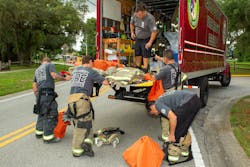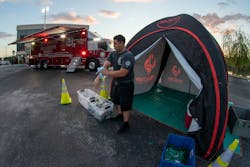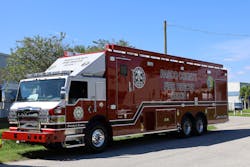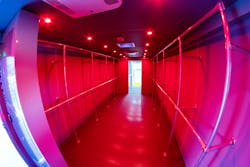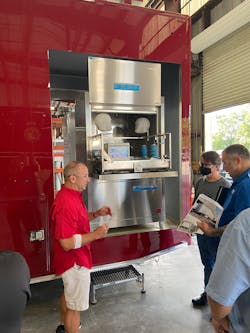Clean on Scene: Reducing the Risks to Firefighters
To decon or not to decon: that should not be the question. The real question is, are you willing to commit to and to protect your most valuable asset, the men and women of your organization who pledged to protect the citizens of your community? The commitment to decontaminate must be more than a check box by the incident commander or fire chief, and the responsibility must be absolutely authentic and impactful.
We are fortunate at Pasco County, FL, Fire Rescue (PCFR) to work for a fire chief, Scott Cassin, who truly recognizes the enhanced hazards and risks of firefighting. Cassin not only acknowledges the danger but is willing to facilitate and fully endorse a program to reduce the risks to his men and women.
The decon program journey
In today’s fire service, one of the latest buzzword is “decon,” but what is that specifically? The Occupational Safety and Health Administration defines decontamination as “the process of removing or neutralizing contaminants that have accumulated on personnel and equipment.”
Studies indicate that approximately 20 carcinogenic chemicals that can affect firefighters, investigators and inspectors are produced during a fire. These carcinogenic chemicals lead to a greater risk to firefighters for certain cancers than is the risk to the public who we serve.
Further, research dove deeper to evaluate how and why individuals in our profession have a more significant threat to some cancers: Carcinogens are attaching to our PPE and to our skin. If we don’t decontaminate immediately, we will cross-contaminate other living spaces, including vehicles, fire stations, personal automobiles, and, possibly, our home and family.
Science and research continue to peel back layers of this complicated onion to reveal solutions to help us to reduce our risks, but not all solutions are easy to implement. On top of that, some of the men and women of today’s fire service are skeptical of change, and who can blame them? Information regarding on-scene decontamination, second sets of gear, washing fire gear and firefighter cancer risks are coming at us so quickly. How do we digest the information? Furthermore, how do we decide what process or procedure is best to implement and when?
Educating the workforce on the risks of cancer, on how firefighters are exposed and on how to minimize exposure is vital. To complete the circle, we must offer a validated and verified program or process to reduce exposure to carcinogens. In my opinion, we must decontaminate our firefighters as much as we do their PPE. It’s essential to offer a process to get our firefighters clean on scene, and the sooner, the better.
The PCFR journey to the current, ever-changing decontamination program started several years ago, when a “Tox-Decon” Administrative Policy and Procedure was built to address the hazards that are experienced at each fire. PCFR recognized potential risks at each fire but was limited in the available processes to mitigate that risk to its firefighters.
As participants who were involved in the effort met about the department’s policy changes, the group members recognized a need to change the process altogether. The group members discussed second sets of gear; after all, that seemed to be the “best practice” within the industry. At the time of the meetings, fewer than half of the department’s firefighters had two sets of gear. PCFR would need to purchase more than a couple of hundred sets of gear to make this a reality.
The process of finding funding to acquire the gear was only part of the problem. Once the department purchased the gear, questions that pertain to where it would be stored, whether firefighters needed to carry both sets of gear when they move stations and who would clean the gear and track it had to be answered.
In 2020, NFPA 1851: Standard on Selection, Care, and Maintenance of Protective Ensembles for Structural Fire Fighting and Proximity Fire Fighting increased advanced cleaning and inspection to twice annually. The new rule increased the annual cost of ownership for PPE and potentially complicated inventory control.
In the hazmat world, where I spent 20 years of my career, a decon hoseline is set up before members enter the hazardous area unless there is an imminent viable rescue. Although it’s unreasonable to believe that we can set up a decon line for working fires before entry, the concept of a hazmat decon line is what PCFR used to build its post-fire decontamination plan.
Is it time to change the way that departments think about fires? I advocate that we look at them from a different point of view. Every fire should be considered a hazmat incident because of the multiple carcinogens that are found in the smoke that’s generated at fires. As with all hazmat incidents, where entry is made into an immediately dangerous to life and health (IDLH) atmosphere, decontamination not only must be a consideration but must be set up before entry. In that consideration, research is completed to confirm that the correct method of decontamination occurs before entry. The same can be said in fire scenarios. PCFR’s pre-incident research indicates that the dangers of the fire scenario IDLH environments require, at minimum, on-scene gross decontamination and the use of approved wipes. As in a hazmat incident, members should spend only the time that’s needed in an IDLH environment to mitigate the incident. The decontamination process must begin when they exit the IDLH environment; best efforts must be made to remove contaminants as quickly as possible.
Utilizing the hazmat concept regarding decontamination of all PPE and equipment led to the conversation that exchanging coats, trousers and hoods isn’t enough. Members must exchange all parts of their PPE ensemble, including coats, trousers and hoods but also helmet headbands, gloves and radio straps. It also means that PPE that can’t be exchanged readily, such as SCBA, SCBA masks, helmets and boots, must be cleaned. As PCFR considered the PPE that it uses in firefighting and evaluated cross-contamination (using dye studies), the department came to believe that a need to exchange all of its PPE on scene was the most appropriate course of action. With the “Clean on Scene” concept in mind, the department decided to look at all levels of the on-scene decontamination process.
Because structural PPE isn’t encapsulated in the way that a hazmat Level A suit is, and because most structure fires that firefighters enter are pressurized containers, the particulates that are in the smoke often attach to members’ skin and uniforms as much as to their PPE. Therefore, it’s reasonable to believe that uniforms are contaminated and that they must be removed as soon as possible. Firefighters then use approved wipes to remove contaminants that accumulated on their skin.
PCFR decided to address this concern with on-the-scene shelters that are set up easily to give firefighters opportunities to clean hard-to-reach places in privacy. Note: The department still requires that firefighters “shower within the hour” once they return to the station.
A significant goal of the Decon 1 program was to return assigned PPE to personnel within 72 hours. The department believed that this would help with the buy-in from firefighters in the field.
In its first year in service, Decon 1 exchanged just short of 400 sets of gear and nearly 500 hoods and utilized about 600 wipes during 70 working structural fires. Throughout the rollout, a local vendor was used to clean and inspect gear. It was found that this caused an unnecessary delay in returning the clean and inspected gear to firefighters. In October 2020, PCFR’s decon technicians began to launder the gear themselves, utilizing the extractor at the station, to combat these delays.
The decon technician is developing into an extremely valuable and important position. As much as the decontamination program is growing and changing, so are the requirements for decon technicians. Technicians are required to attend and complete a manufacturer-sponsored NFPA 1851 course and to be certified by the manufacturer. Additionally, they are responsible for managing all PPE for their assigned shift, including assigning gear, sending gear for repair, recommending a replacement, inspection and, of course, cleaning.
As the program grows, a need to expand position requirements is materializing, and the current task book is under revision. Primary and alternate technicians must have the same level of training.
Act now
The discussion about on-scene decontamination and cancer prevention hits very close to home for PCFR. One of our brothers, a PCFR firefighter and alternate decon technician, is battling brain cancer. He is an inspiration to us all with his courage and determination and wants to get the word out about the importance of a robust on-scene decontamination program.
We all have names of members who have battled cancer. This should be our inspiration to never stop the research for reducing the number of firefighters who get cancer.
There is a lot of discussion about “best practices,” particularly regarding on-scene decontamination. That said, the on-scene decontamination concept only has been around for a few years. So, what makes a practice the “best practice”? For me, the best practice is to do something. It often will be found that logistics, finances and geography restrict what can be done regarding a decontamination program. You should trust that best practices will be identified over time.
For cancer prevention and decontamination, this I know: We all must do something, now. We all have water on scene and can wash off carcinogens that accumulated on our PPE before leaving. We also can have wipes to clean the PPE interface areas on our bodies (head, face, neck, wrists and waist). This is a minimal cost, but the value of our firefighters is enormous and no longer can be ignored.
About the Author
John Schmidt
John Schmidt, who is a 35-year fire service veteran, is Division Chief-Health, Safety and Wellness for Pasco County, FL, Fire Rescue. His responsibilities include decontamination, rehab, ICO, air truck and peer fitness programs. Earlier in his career, Schmidt served: 20 years on the Pinellas County, FL, Hazardous Materials Response Team, including three years as the commander; 13 years on the Pinellas County Technical Rescue Team; and as an adjunct instructor for the St. Petersburg College Fire Academy. He maintains a membership with many organizations, including Fire Department Safety Officers Association, Florida FACE Team, Florida Fire Chief’s Association and International Association of Fire Chiefs.
